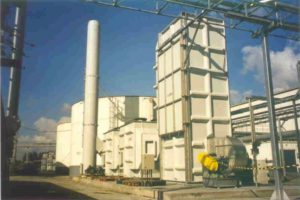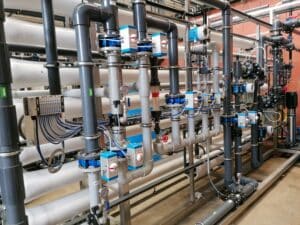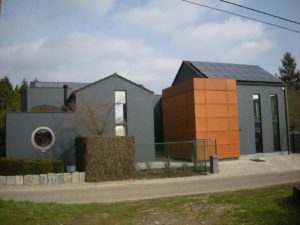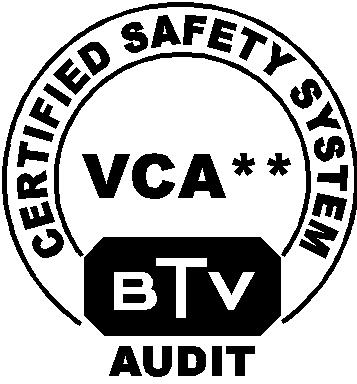THE UNDERESTIMATED BIOROTOR – A classic staple with a new twist
(Ecomagazine June 2008)
For more than 10 years now, animal park Planckendael has been proving that is was an ideal solution to opt for a biorotor for the waste water treatment of its animal hospital. Unfortunately, there are only few Belgian companies to follow its example. And that’s a pity, because in the long run, the advantages cannot be neglected.
Planckendael is a young , spacious and open walking park with large animal accomodations, well integrated in the landscape. Some parts of the park remain untouched, allowing the visitor to find wild plants and flowers throughout the year. Durable management is an important issue for the domain’s board (rewarded in 2004 by the VBO – Association of Belgian companies – with the Reward for best Environmental Management).
And since more than 15 years Prof. Rik Van de Werf, University Teacher Environmental Care at the Erasmus College of Higher Education and University Teacher Environmental Techniques at the VUB University of Brussels, is playing an important role in this field. Because it was he who conceived in 1994 an installation for the purification of the waste water originating from an important part of the animal accomodations, from the sanitary facilities in the park, the animal kitchen and the restaurant.
From wastewater up to drinking water
Three years later the domain’s board came knocking at the professor’s door once more. Because Planckendael was forced to find a solution for the waste water coming from the breeding birdhouse. This was discharged into a side channel of the Barebrook, but new regulations now called for water treatment. After thorough analysis of the situation Prof. Rik Van de Werf came to the conclusion that the combination of a biorotor with a constructed wetland was the best solution. He is explaining why : “This system is offering a high resistance to fluctuations in the degree of pollution : necessary for this kind of application as in summer there are more jung birds in the cage, and thus also more polluting manure than in winter. Besides, this solution is taking hardly any space. And that was a welcome bonus, as we only had 100 m2 at our disposal.”
But what is it all about?
The biorotor consists of a cylinder with a rotating spindle holding circular discs. “65 in total”, Prof. Van de Werf clarifies. “At one end, the wastewater flows in, at the other end the purified water flows out. Between all those circular discs, there is a porous, synthetic filling. Each pore has a well-defined surface. Small of course, but when you add the surface of all pores, you’ll get a very large total surface. About a third of each disc is hanging into the polluted water. When the spindle is turning, the wet part of the disc reaches a bit above the water surface. This way, it reaches not only the wastewater, but gets also a little bit of oxygen into the pores and to the micro-organisms growing within. These microbes nourrish themselves with the pollutants from the wastewater, thus purifying it. After a while they will produces sludge plates between the discs, who will eventually detach and fall into the water in big lumps, catched by a downstream sandfilter to separate them from the water.”
As the wastewater is not sufficiently filtered after the biorotor treatment, the water is then conducted through the sandfilter into a helophyte field (only 1,5 meter away). Prof. Van de Werf explains: “Helophytes are plants, growing partly under water, just like reed. The water is slowly rippling through the root area of the field. On the roots of the plants micro-organisms are growing, feeding themselves with the dirt in the water. Those who don’t do this are disadvantaged and will compete with those who do and thus absorb more nutrients. The pollutants processed in their metabolism will produce several substances serving at their turn as food for the helophytes. The plants itself produce oxygen, which will be led through the hollow stalks to the bacteria, allowing them to breathe. This way, plants and micro-organisms are helping each other and together they are extracting the pollutants from the water.”
Ecologically sound and economically operated system
This is an ecologically sound and very economically operated system : the purification of the water is obtained in a completely natural way, the required energy (rotation of the spindle) is reduced to an absolute minimum. The question is, of course, why this system isn’t adopted on a much larger scale. Because a biorotor such as in Planckendael isn’t used that much, certainly not in an industrial environment.
Stefaan Kovacs, Manager of Task Environmental Engineering, who installed the wastewater treatment plant as conceived by Prof. Van de Werf, is commenting. “In an industrial environment mainly systems with activated sludge are used. Water is then mixed with micro-organisms in large aeration tanks, resulting in sludge flakes who will be separated from the water in decantation tanks. A biorotor is also functioning according to this principle of sludge on a support. Activated sludge systems are generally cheaper in purchase (especially for residential and small-scale applications) than a biorotor and do not require a second, separate step to purify the water entirely from all its nutrients. The activated sludge system as well as the biorotor system in their base configuration are often not sufficient to purify the water entirely. On the other hand, the advantage of the activated sludge concept is that the necessary extra purification can, in most cases, be integrated in an existing installation, what is cheaper than adding another module, which would be the case with a biorotor. An example of extra purification, easy to integrate in an activated sludge system is in case of phosphor and nitrogen removal from industrial wastewater. The phosphor can for instance be removed by adding certain chemicals such as iron or aluminium chloride whilst nitrogen is removed in a microbiological way.
Nevertheless, I think that these two disadvantages are largely compensated by the advantages of the biorotor. The aeration of the biorotor is obtained in a natural way, without the use of a compressor for air injection, all that is needed is one single motor to get the spindle with the discs moving. An activated sludge system, on the contrary, is requiring several electronically steered and fully automatic air pumps for the aeration of the water, which will result in a 10 times higher energy consumption. The biorotor installation requires hardly any maintenance and the installation’s principle is quite simple, so that a possible problem can be quickly solved. This lower operation cost for the aeration of the biorotors can make it a more economic system in the long run, compared to other purification systems. And then I haven’t even mentioned that a biorotor hardly requires any space at all… I think industry has a far too restricted view on the biorotors’ advantages, especially those in the long term. Industries with biodegradable wastewater in particular, could better seriously consider a biorotor solution. Think for instance about agricultural companies and the food processing industry, such as vegetable processing companies.”
Also for relatively small municipal wastewater treatment plants, such as residential areas out of reach, campings and so on, a biorotor can offer an interesting alternative.




